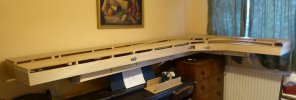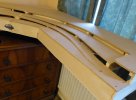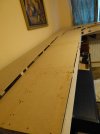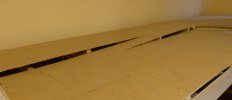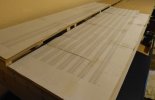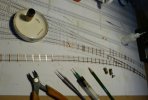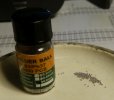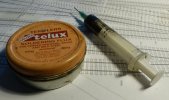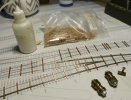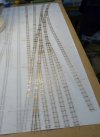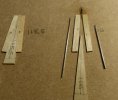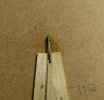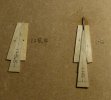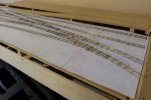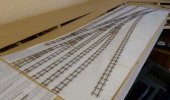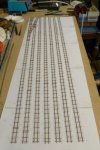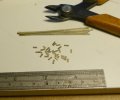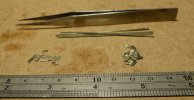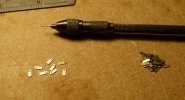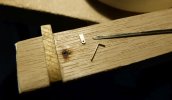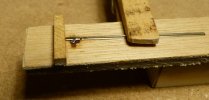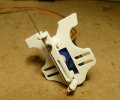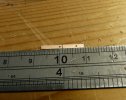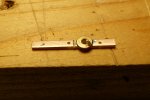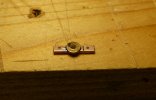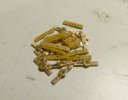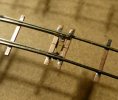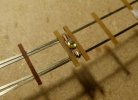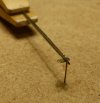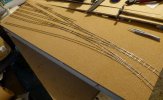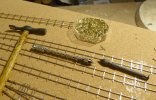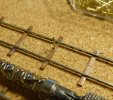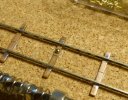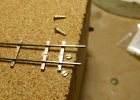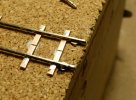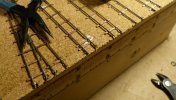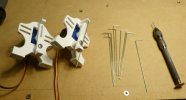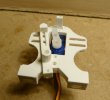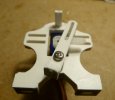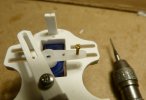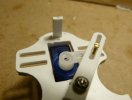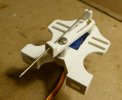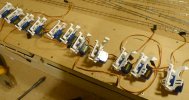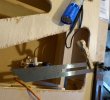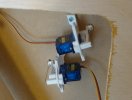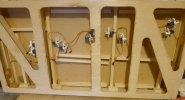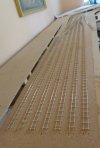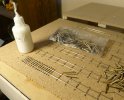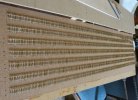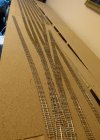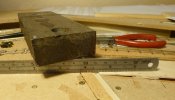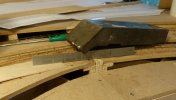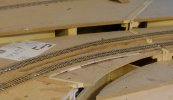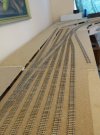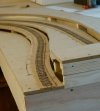Two years on and a lot has changed.

I ran into more problems trying to get crossing noses far enough apart to let the frog juicers work. I had redesigned the layout a few times to try and overcome this but I started to run into other problems. When I first built the layout I had experimented using the coils and pole pieces from Carpenter relays to operate the knuckle couplers. These coils and pole pieces were quite large so there were quite a few large holes in the baseboard top to accommodate them, all hidden under the cork sheet underlay. When I started moving the track around in Templot to solve the problems with the frog juicers, these holes became a problem. So things were put on the back burner until I could work out a solution.
And the solution was to scrap the existing layout and build a new one.

And the new one would be built along a wall of the lounge rather than be a free standing layout as the previous one was. My problem with a free standing layout was that it would have to be set up every time it was used, and shut down when finished. Whereas a "permanent" layout would avoid all that. So a new layout plan was drawn up :-
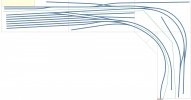
Not quite "less is more".

But it's basically a four road yard with various industries along the back of the layout. The main line is the inner road coming from the lower right and that will be fed by a fiddle stick taking a cassette. I've also put a bit of relief into the layout to get away from the flat earth look with the incoming main road rising to the yard and the feed from the yard to the industries rising even further. The green lines on the plan show the breaks between the different levels. The pointwork on the layout is also quite straightforward with no complex formations since I want to use frog juicers and don't want any problems.

The area for the layout is in the rear corner of the lounge over the piano.
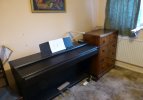
The layout will be supported on the four brackets - two over the piano and two on the end wall over the chest of drawers and the radiator. The chest of drawers has been re-purposed from a bedroom suite to hold a lot of railway stuff - N scale stock on the top drawer, DCC equipment and S scale bits in the second, and various power supplies and wall warts in the third.
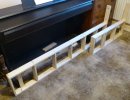
The baseboards will sit on a sub frame, shown here on the floor in front of the piano.
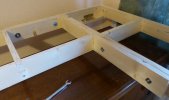
The two parts of the subframe are bolted together using 6mm bolts and Teenuts...
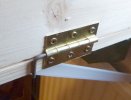
...and the sub-frame is locked in place on the brackets using hinges and pins.
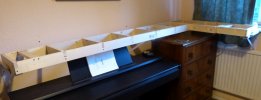
The sub-frame on the brackets.
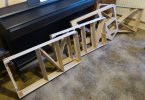
There are four baseboards, intentionally made on the small side to keep weight down and be easy to handle.

The four boards are now in place giving an "L" shaped layout, 8' 6" long x 4' 6" deep.
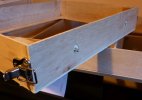
The baseboards are aligned with dowels and the toggle latches hold them together.

The baseboards are fixed on the sub-frame using bolts and Teenuts through stretchers on the subframe and the ply base of the baseboards. There are two bolts - one at each end of the layout.
"Dirty" work on the layout can be done elsewhere since the boards are easily removed from the frame and sub-baseboard electrical work can be done more easily by removing and upending boards.
Also, if the layout ever ventures onto the exhibition circuit, it can go as baseboards only to sit on a couple of tables, or three legs could be attached to the three corners of the sub frame to make a free-standing layout.
The Easybus system built for the previous layout can be adjusted to work with this one. I've already mapped out a new control panel for it and it will just be a case of re-routing wires on the panel. The servo setups on the previous layout were designed for tube-in-wire operation and also had micro-switches incorporated for polarity switching. I can't use them in this layout, so I will have to make new servo setups to operate under the trackbed. Since I'm going to use frog juicers on every turnout, they can be quite simple setups with no polarity switches.
All the rail has been recovered from the previous layout, including all the machined point blades.
The large warehouse made for the previous layout will also be re-used, its position on the layout being shown by the yellow rectangle in the top left hand corner of the layout plan.
Onwards and upwards - maybe.

Jim.


 I did a rig on the CNC machine to produce the blades for my S scale switching layout a year or two ago so I'll see if I can do the same thing in N scale but it might be a bit tricky with Code 40 FB rail. But with fourteen sets of blades required it will be worth it to make it happen.
I did a rig on the CNC machine to produce the blades for my S scale switching layout a year or two ago so I'll see if I can do the same thing in N scale but it might be a bit tricky with Code 40 FB rail. But with fourteen sets of blades required it will be worth it to make it happen. 











 . Well it does work but too well. The uncoupler is placed so that the magnets are on each side of the couplers and the couplers should then be attracted outwards which opens the Kadees. But the problem is that when the coupler arms start moving towards the magnets, the attraction gets stronger and stronger and this is sufficient haul the coupler hooks out over the rails and pull the wheels off the tracks. Back to the drawing board.
. Well it does work but too well. The uncoupler is placed so that the magnets are on each side of the couplers and the couplers should then be attracted outwards which opens the Kadees. But the problem is that when the coupler arms start moving towards the magnets, the attraction gets stronger and stronger and this is sufficient haul the coupler hooks out over the rails and pull the wheels off the tracks. Back to the drawing board. 
















